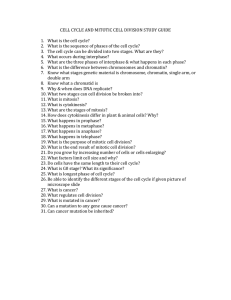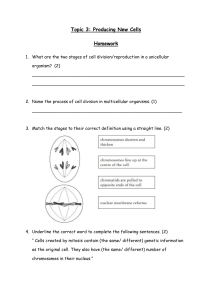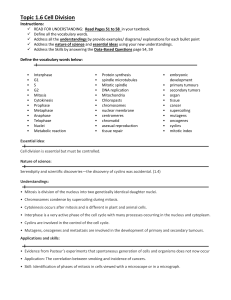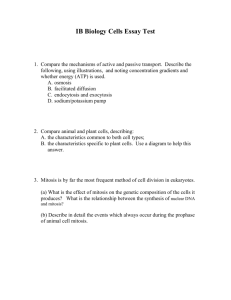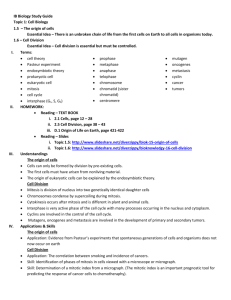Cytological effects of the root extracts of Boerhaavia diffusa
advertisement
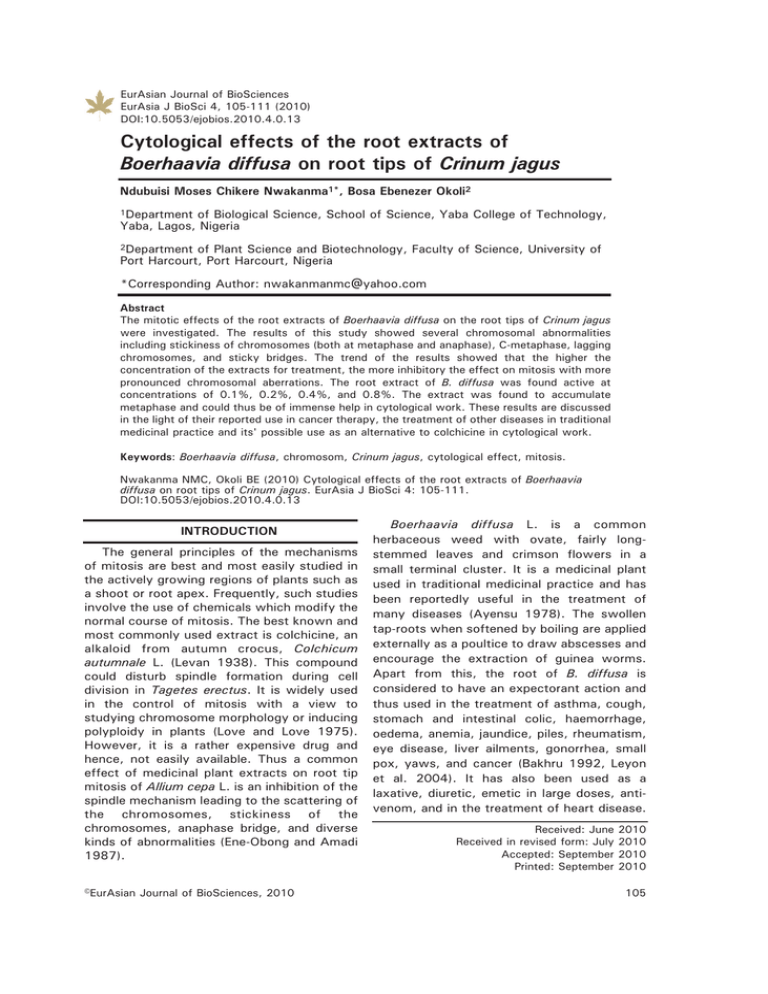
EurAsian Journal of BioSciences EurAsia J BioSci 4, 105-111 (2010) DOI:10.5053/ejobios.2010.4.0.13 Cytological effects of the root extracts of Boerhaavia diffusa on root tips of Crinum jagus Ndubuisi Moses Chikere Nwakanma1*, Bosa Ebenezer Okoli2 1Department of Biological Science, School of Science, Yaba College of Technology, Yaba, Lagos, Nigeria 2Department of Plant Science and Biotechnology, Faculty of Science, University of Port Harcourt, Port Harcourt, Nigeria *Corresponding Author: nwakanmanmc@yahoo.com Abstract The mitotic effects of the root extracts of Boerhaavia diffusa on the root tips of Crinum jagus were investigated. The results of this study showed several chromosomal abnormalities including stickiness of chromosomes (both at metaphase and anaphase), C-metaphase, lagging chromosomes, and sticky bridges. The trend of the results showed that the higher the concentration of the extracts for treatment, the more inhibitory the effect on mitosis with more pronounced chromosomal aberrations. The root extract of B. diffusa was found active at concentrations of 0.1%, 0.2%, 0.4%, and 0.8%. The extract was found to accumulate metaphase and could thus be of immense help in cytological work. These results are discussed in the light of their reported use in cancer therapy, the treatment of other diseases in traditional medicinal practice and its' possible use as an alternative to colchicine in cytological work. Keywords: Boerhaavia diffusa, chromosom, Crinum jagus, cytological effect, mitosis. Nwakanma NMC, Okoli BE (2010) Cytological effects of the root extracts of Boerhaavia diffusa on root tips of Crinum jagus. EurAsia J BioSci 4: 105-111. DOI:10.5053/ejobios.2010.4.0.13 INTRODUCTION The general principles of the mechanisms of mitosis are best and most easily studied in the actively growing regions of plants such as a shoot or root apex. Frequently, such studies involve the use of chemicals which modify the normal course of mitosis. The best known and most commonly used extract is colchicine, an alkaloid from autumn crocus, Colchicum autumnale L. (Levan 1938). This compound could disturb spindle formation during cell division in Tagetes erectus. It is widely used in the control of mitosis with a view to studying chromosome morphology or inducing polyploidy in plants (Love and Love 1975). However, it is a rather expensive drug and hence, not easily available. Thus a common effect of medicinal plant extracts on root tip mitosis of Allium cepa L. is an inhibition of the spindle mechanism leading to the scattering of the chromosomes, stickiness of the chromosomes, anaphase bridge, and diverse kinds of abnormalities (Ene-Obong and Amadi 1987). ©EurAsian Journal of BioSciences, 2010 Boerhaavia diffusa L. is a common herbaceous weed with ovate, fairly longstemmed leaves and crimson flowers in a small terminal cluster. It is a medicinal plant used in traditional medicinal practice and has been reportedly useful in the treatment of many diseases (Ayensu 1978). The swollen tap-roots when softened by boiling are applied externally as a poultice to draw abscesses and encourage the extraction of guinea worms. Apart from this, the root of B. diffusa is considered to have an expectorant action and thus used in the treatment of asthma, cough, stomach and intestinal colic, haemorrhage, oedema, anemia, jaundice, piles, rheumatism, eye disease, liver ailments, gonorrhea, small pox, yaws, and cancer (Bakhru 1992, Leyon et al. 2004). It has also been used as a laxative, diuretic, emetic in large doses, antivenom, and in the treatment of heart disease. Received: June Received in revised form: July Accepted: September Printed: September 2010 2010 2010 2010 105 EurAsian Journal of BioSciences The root has been reported to contain about 0.04 per cent of punarvavine an alkaloid, boerhaavic acid, reducing sugars, potassium, nitrate, and tannins including phlobaphenes (Bakhru 1992). These medicinal values of B. diffusa and the contents of its root necessitated its use in mitotic studies. The genus Crinum is represented by so many species. Two of these have been found in Nigeria and are classic ornamentals. They decorate both the landscape and private gardens when in bloom. Like most members of the family Amaryllidaceae, they flower by mid-dry season and bloom till the beginning of the rains in May. The two species are C. ornatum (Ail.) Bury Hexander, C. jagus (Thomps.) Dandy (Nwankiti 1985). Apart from C. octabilis (2n= 33), 14 species investigated all had 2n= 22 C. jagus was used for the purpose of this study. Allium cepa (onion) is commonly used in studies of this kind. This mainly because A. cepa roots easily and contain few chromosomes (2n= 16) which make it very suitable for cytological studies and for any aberrations to be very clearly elucidated (Okoli and Russom 1986). However, A. cepa is an expensive crop since it is used as a condiment in human nutrition. On the other hand, C. jagus, as has been pointed out could either be found in the wild or private gardens where they decorate such places when in full bloom. No extra cost is involved in acquiring the Crinum species for research purposes. C. jagus and A. cepa belongs to the same family Amaryllidaceae. Using C. jagus therefore is an innovation aimed at finding a suitable substitute for the more expensive A. cepa crop. The only possible disadvantage in using C. jagus for this kind of work is that it has relatively more chromosomes (2n= 22), and its roots are quite larger than those of A. cepa. However, this set-back is circumvented by slicing the root into thin longitudinal sections which make them more amenable to cytological manipulations after treatment with the test substance. In this research, the cytological effects of the root extracts of B. diffusa on the root tips of C. jagus was investigated with a view to finding some 106 Nwakanma and Okoli possible use of these extracts as chemicals for the modification of mitosis in much the same way as colchicine. Colchicine is a very expensive drug which is not easily available for research work (Okoli and Russom 1986). The economic potentials of the observations made are discussed. MATERIAL AND METHODS Bulbs of Crinum jagus were used as test material for this experiment. They were dug up from the Botanical garden at the University of Port Harcourt where they had been growing or were cultivated. Different sizes were selected, the smaller bulbs having smaller roots than the bigger ones which have roots many times that of Allium cepa. The root tips (between 1-2 cm in length from the root apex) were cut off and sectioned to produce thinner longitudinal sections which are amenable to cytological treatments. B. diffusa roots were obtained around the Choba campus of the University of Port Harcourt where they were mainly found to be growing near buildings and or in hard places with cement work. The roots were subjected to a very good washing with water as much as was necessary to remove all the attached soil and dirt. After this, they were sliced to expose a greater surface area and to facilitate drying. The sliced specimens were oven-dried at a temperature between 40-60°C. The dried specimen was then crushed in a mortar to a semi-powdered form. About 200 g of the crushed specimen was weighed out into a thimble of a soxhlet extractor and the reflux extraction was carried out in a fume chamber. For the extraction, two solvents were used successively. Firstly petroleum ether was used. This was mainly for the de-fattening of the specimen. There after chloroform was used which effected the alkaloid extraction from the specimen. It took 14-16 h for the complete exhaustion of the root with each solvent. The solvent was distilled off and the extract weighed. The fatty components obtained after the extraction with petroleum ether were discarded while the extract obtained after the extraction with chloroform ©EurAsian Journal of BioSciences, 2010 EurAsian Journal of BioSciences was dried and weighed. It gave 0.2 g dry weight alkaloid for Boerhaavia diffusa and from this, various concentrations of the test solutions were made at 0.1%, 0.2%, 0.4%, and 0.8% concentrations while using tap water as control. The roots of the Crinum jagus were randomly selected from the bulbs and sampled by cutting them off the bulbs with a sharp razor blade. They were sliced to desirable sizes and placed in a watch glass with water. They were then treated with the test substances in vials containing about 2 mL of extract at different concentrations for 3 h. This treatment is best from between 10.00 a.m and 1.00 p.m in the day. This is because mitotic activity has been found to be at its best within this time of the day. There after, the roots were fixed in a freshly prepared 1:3 glacial acetic acid, 95% alcohol (V/V), for at least 24 h at 4°C, then stored in 70% alcohol under refrigeration until required. For control purposes, another group of randomly-selected roots were taken and treated with tap water instead of the test solutions after they were cut and fixation was carried out as previously described. For each period of collection, each root tip was later randomly selected for slide preparation. Hydrolysis of the roots was carried out in 8% HCl for about five min. This is to facilitate the disintegration of the middle lamella of the cell staining. This treatment preceded their stabilization before squashing was done. About 2 mm of the opaque end of the root tip was sectioned off with a sharp razor blade and used for slide preparation. For examination of mitotic chromosomes, root tips were squashed in an FLP-orcein (2 g of Orcein dissolved in 10 mL of solvent, containing equal parts of formic acid, lactic acid, propionic acid and water), following the method of Okoli (1983). The materials were squashed directly by tapping with the blunt end of a ball point pen, to cause the cells to spread out properly. Slides were viewed at X400 magnification. The frequencies of mitotically dividing cells were scored by sampling portions of slides which showed unambiguity in the configurations of mitotic ©EurAsian Journal of BioSciences, 2010 Nwakanma and Okoli cells. The mitotic index was defined as the ratio of dividing cells to the total number of cells examined for each treatment (Balog 1982). The effect of different concentrations and duration of treatment of the extract on the frequencies of the four phases of mitosis was determined. Microphotographs of chromosomal aberrations were taken from the temporary slides following the method of Okoli and Russom (1986) (Fig. 1). RESULTS The extract exhibited a strong depressive effect on the mitosis of C. jagus roots. In the B. diffusa extract used, the mitotic index of the control experiment was found to be 5.27%. As for the treatment, at concentration of 0.1%, 0.2%, 0.4%, and 0.8% the mitotic indices were found to be 4.80, 3.59, 3.47, and 3.36 respectively. Thus, there was a negative correlation between the concentrations of the treatment extracts and the mitotic indices obtained from their action (Table 1). This points to an inhibition of mitosis by this extract. Inhibition of the mitotic index increased significantly with an increase in the concentration of treatment solution of B. diffusa. This again shows a very negative correlation between the concentration of the extract and the mitotic indices produced by the observed action. The untreated roots (controls) had high mitotic indices in all the mitotic phases. Table 2 shows the chromosome aberrations in C. jagus root tip cells treated with different concentrations of B. diffusa root extract in the experiment. Other significant observations made for the various concentrations and treatments are presented in the form of microphotographs (Fig. 1). DISCUSSION The worldwide use of B. diffusa roots to treat liver disorders was validated when researchers demonstrated, in 1980 and 1991 that its root extract had antihepatotoxic properties (Chandan et al. 1991, Rawt et al. 1997). The plant has also been shown to 107 EurAsian Journal of BioSciences Table 1. Mitotic effects of root extract of B. diffusa on the C. jagus root tip cells. Fig. 1. Microscopic effects of aqueous extracts of B. diffusa on C. jagus root tips. (a) Regular metaphase and telophase from control X400. (b) Sticky chromosome and seriously disturbed anaphase caused by B. diffusa extract at 0.8% concentration, X400. (c) Sticky metaphase caused by B. diffusa extract at 0.8% concentration, X400. (d) Metaphase caused by B. diffusa extract at 0.2% concentration, X400. possess strong anti-cancer properties (Rupyoti et al. 2003, Leyon et al. 2004), antimicrobial properties (Olukoya et al. 1993), anticonvulsant and antispasmodic effects (Adesina et al. 1979, Borelli et al. 2006) as well as being used in the control of viral diseases of vegetable crops (Awasthi et al. 1985). In Nigeria, the roots of B. diffusa are used to manage dropsy and infertility problems (Aiyeloja and Bello 2006). Onyenwe (1983) had reported that the root extract of B. diffusa is used in traditional medicinal practice while Ene-Obong and Amadi (1987) had reported that the water extracts of B. diffusa exerted mitodepressive effects on A. cepa 108 Nwakanma and Okoli root tip mitosis. This result agrees with the results obtained in this present work. In the Indo-Nepal Himalayan terai region, the tribals harvest this plant for medicinal purposes, mainly for flushing out the renal system and to treat seminal weakness and blood pressure (Mitra and Gupta 1997). In the light of the results obtained in the present study, these observations above may be due to the nucleotoxic action of the extracts or the disturbance of the formation of spindle fibres during cell division which leads to chromosomal aberrations. Stickiness and clumping of the chromosomes were some of the most common effects of these extracts on the treated root tips. These abnormalities have also been reported for several extracts and chemicals already investigated (Badr and Elkington 1982, Misra 1982, Nwakanma et al. 2009). Stickiness usually leads to the formation of anaphase and telophase bridges and this end up inhibiting metaphase and cytokinesis respectively and thus hampering cell division. Stickiness might be due to the ability of the extracts to cause DNA depolymerization and partial dissolution of nucleoproteins, breakage and exchanges of the basic folded units of chromatids and the stripling of the protein covering of DNA in chromosomes as also observed by Onyenwe (1983). The consistently high frequency of interphase observed in all the concentrations was expected since that stage lasts much longer than the other stages of mitosis. Even though many aberrations were observed at metaphase in high concentration of the extract, the frequency of prophase was still high enough to indicate that even the treated cells to some degree, go through prophase of mitosis normally. This observation further suggests that these extracts are potent spindle fibre inactivators and thus can supplement the use of colchicines or hydroxyquinoline in pretreating materials for mitotic studies. This is in agreement with the findings of some earlier workers (Ilevbare 1983, Onyenwe 1983). C. jagus, which is in the same family as A. cepa (Amaryllidaceae), was used and gave very good results which are comparable to ©EurAsian Journal of BioSciences, 2010 EurAsian Journal of BioSciences Nwakanma and Okoli Table 2. Chromosome aberrations of the C. jagus root tip cells treated with different concentrations of B. diffusa root extracts. those obtained by other researchers who have used A. cepa root tips (El-Bayoumi et al.1979, Kabarity and Malallah 1980, Ilevbare 1983). This innovation is particularly important against the background of the fact that A. cepa is an edible and hence economic plant to humans. C. jagus on the other hand is not edible and grows in the wild. The results from this work strongly suggest that C. jagus can now be used as an alternative to the hitherto-used edible and economic plants - A. cepa for cytological work. Furthermore, owing to the ability of the root extracts of B. diffusa to accumulate metaphase and hence inhibit mitosis, it is possible to use these extracts as an alternative to the rather expensive colchicine for cytological studies. ACKNOWLEDGEMENT We wish to thank Dr. Shode - the Head of Department, Department of Chemistry, University of Port Harcourt, Rivers State, Nigeria for allowing us use the Chemistry laboratory for the soxhlet extractor at the time of this work. REFERENCES Adesina SK (1979) Anticonvulsant properties of the roots of Boerhaavia diffusa. Quarterly Journal of Crude Drug Research 17: 84-86. Aiyeloja AA, Bello OA (2006) Ethnobotanical potentials of common herbs in Nigeria: A case study of Enugu State. Educational Research and Review 1(1): 16-22. Awasthi LP, Pathak SP, Guatam NC (1985) Control of virus disease of vegetable crops by a glycoprotein isolated from Boerhaavia diffusa. Indian Journal of Plant Pathology 3: 311-327. Ayensu ES (1978) Medicinal plants of West Africa. Algonac, Michigan. Badr A, Elkington TT (1982) Antimitotic and chromotoxic activities of Isoproturon in Allium cepa and Hordeum vulgare. Environmental and Experimental Botany 2: 265-270. Bakhru HK (1992) Herbs that heal: natural remedies for good health. Orient Paperbacks, New Delhi. Balog C (1982) The mitotic index in diploid and triploid Allium roots. Cytologia 47: 689-697. Borelli F, Ascoine V, Capasso R, Izzo AA, Fattorusso E, Scafati OT (2006) Spasmolytic effects of Nonprenylated Rotenoid constituents of Boerhaavia diffusa Roots. Journal of Natural Products 69(5): 903-906. Chandan BK, Sharma AK, Anand KK (1991) Boerhaavia diffusa: A study of it's hepatoprotective activity. Journal of Ethnopharmacology 31(3): 229-307. El-Bayoumi AS, Kabarity A, Habib A (1979) Cytological effects of papaverine hydrochloride on root tips of Allium cepa L. Cytologia 44: 745-755. Ene-Obong EE, Amadi OC (1987) Contributions to the cytological effects of medicinal plants: The mitodepressive effects of water extracts of Boerhaavia diffusa and Vernonia amygdalina on Allium cepa root tip mitosis. Cytologia 52: 469-474. ©EurAsian Journal of BioSciences, 2010 109 EurAsian Journal of BioSciences Nwakanma and Okoli Ilevbare UK (1983) A study on mitotic effects of water extracts of Cassia alata and Alchornea cordifolia on Allium cepa root tip cells. University of Port Harcourt, Port Harcourt, Nigeria. Kabarity A, Malallah G (1980) Mito-depressive effect of knot extracts in the meristematic region of Allium cepa root tips. Cytologia 45(4): 730-733. Levan A (1938) The effect of colchicine on root mitoses in Allium. Hereditas 24: 471-486. Leyon PV, Lini CC, Kuttan G (2004). Inhibitory effect of Boerhaavia diffusa on experimental metastasis by B16F10 melanoma in C57BL/6 mice. Life Sciences 76(12): 1339-1349. Love A, Love D (1975) Plant chromosomes. Lubrecht and Cramer Ltd, Monticello, NY. Misra MP (1982) Effect of calcium salts on Allium cepa chromosomes. Cytologia 47: 47-51. Mitra R, Gupta RC (1997) Punarnava -An Ayurverdic drug of repute. Applied Botany Abstracts 17(3): 209-227. Nwakanma NMC, Odeigah PGC, Oboh BO (2009) Genotoxic Effects of Gongronema latifolium and Vernonia amygdalina using the Allium Test. In: Book of Proceedings, 4th UNILAG Conference and Fair, Nigeria, October 21-22, 2009, 81-90. Nwankiti OC (1985) Cytotaxonomic survey of some tropical ornamental species V. Karyotype of two species of the genus Crinum and a related genus Hymenocallis. Cytologia 50: 797803. Okoli BE (1983) Hybridization, polyploidy and apomixis in Andropogon tectorum Schum. and Thonn. (Gramineae). New Phytologist 93(4): 591-597. Okoli BE, Russom Z (1986) Effects of an aqueous extract of Cassia alata L. on mitosis of onion (Allium cepa) roots. Biologia Africana 3(1-2): 31-37. Olukoya DK, Tdika N, Odugbemi T (1993) Antibacterial activity of some medicinal plants from Nigeria. Journal of Ethnopharmacology 39: 69-72. Onyenwe CN (1983) Cytological effects of seed extracts of Abrus procatorius on the mitosis of Allium cepa and the effect of root extract of Boerhaavia diffusa on mitosis of Crassocephallum biafrae. University of Port Harcourt, Port Harcourt. Rawat AKS, Mehrotra S, Tripaathi SK, Sharma U (1997) Hepatoprotective activity in Punarnava - a popular India ethnomedicine. Journal of Ethnopharmacology 56: 61-68. Rupjyoti BR, Mohammed RHA, Jawahira T (2003) Chemopreventive action of Boerhaavia diffusa on DMBA-induced skin carcinogenesis in mice. Indian Journal of Physiology and Pharmacology 47(4): 459-464. 110 ©EurAsian Journal of BioSciences, 2010 EurAsian Journal of BioSciences Nwakanma and Okoli Boerhaavia diffusa Kök Özütlerinin Crinum jagus Kök Uçlari Üzerine Sitolojik Etkileri Özet Boerhaavia diffusa'nin kök özütlerinin, Crinum jagus kök uçlari üzerine mitotik etkileri incelendi. Bu çalismanin sonuçlari, kromozom yapiskanligi (hem metafaz hem de anafazda), C-metafaz, izole kromozomlar ve yapiskan köprüler gibi kromozomal anormallikler ortaya koydu. Sonuçlar; uygulanan özütlerin konsantrasyonu arttikça, mitoz üzerinde daha büyük bir inhibitor etkinin gittikçe artan kromozomal bozukluklarla birlikte ortaya çiktigini göstermektedir. B. diffusa bitkisinin kök özütlerinin %0.1, %0.2, %0.4 ve %0.8 konsantrasyonlarda aktif oldugu bulundu. Özütün, metafazi biriktirdigi ve bu özelligi nedeniyle sitolojik çalismalarda son derece faydali olabilecegi bulundu. Bu sonuçlar; kanser terapisinde kullanim, geleneksel tiptaki diger hastaliklarin tedavisinde kullanim ve sitolojik çalismalarda kolsisine bir muhtemel bir alternatif olarak kullanim isiginda tartisildi. Anahtar Kelimeler: Boerhaavia diffusa, Crinum jagus, kromozom, mitoz, sitolojik etki. ©EurAsian Journal of BioSciences, 2010 111

